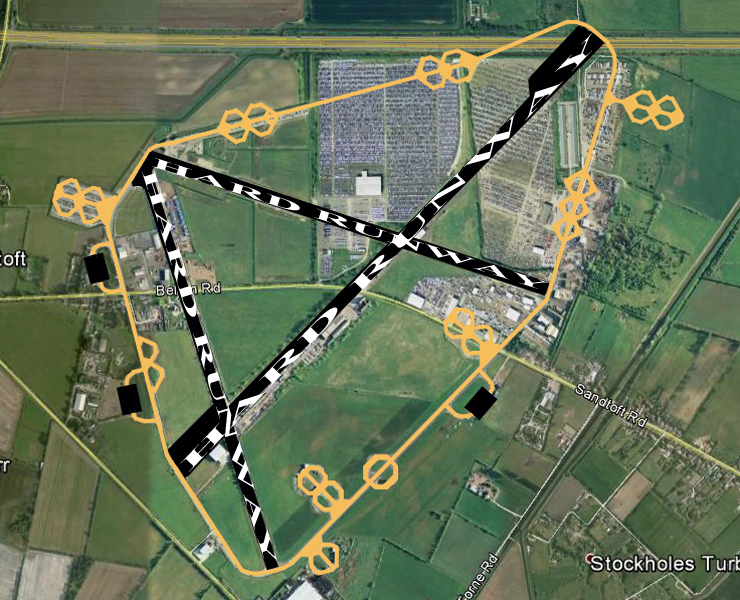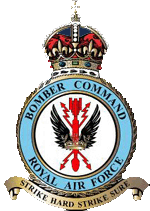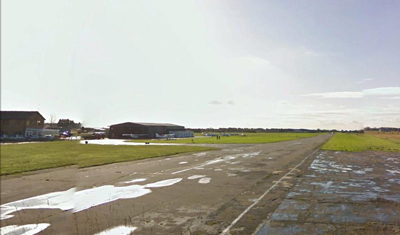Sandtoft Airfield History

(Map edited to show the airfield and runways between 1940-45)

© Crown Copyright/MOD 2010
53°33'52.2"N 0°51'51.0"WWartime Runways:
12/30 & 17/35 4200ft x 150ft - 06/24 6000ft x 150ftCurrent Runway:
05/23 2907ft x 59ft
The first site surveys of what was to become RAF Sandtoft began in January 1942. The site finally chosen was located 1 mile WNW of Belton Church, and work began on the 23rd October 1942. The station was built to the standard Class ‘A’ design, with three runways crossing each other surrounded by the peri-track. The technical site was made up of three hangars, two T2’s and one B1. Both the T2’s were located just off the western peri-track, with the single B1 located just off the eastern peri-track. Both the accommodation and communal sites were located on the western side of the station close to the local public House.
Once completed the station was planned to become a satellite of RAF Lindholme which in turn was controlled by 11 Base, 1 Group Bomber Command. The station was pencilled in to receive its first operational unit on the 10th January 1944, so with this in mind the airfield began to open on 12th December 1943, despite it not being completely finished.
The mid-January date came and passed without any sign of its first residents. It wasn’t until the 18th February 1944 that the first aircraft would arrive bringing with it the stations first operational residents, in the shape 1667 HCU ‘A’ Flight. Both ‘B’ and ‘C’ flights were to arrive the following day, with flying training commencing almost immediately. With the arrival of 1667 personnel, came the stations first aircraft in the form of the Handley Page Halifax.
Both the numbers of personnel and aircraft were to be increased again only a few months later with the formation of a fourth flight at the station during July 1944. This flight was instantly named the Flying Instructors Flight and was used to carry out the standardisation flying for all the instructors operating within 11 Base.
More change was soon affecting the station when on the 5th November 1943, 11 Base was transferred to 7 Group and subsequently renumbered 71 Base. This change also brought in more personnel, with a small detachment from 1656 HCU moving in. With this change of control also came a change of aircraft at the airfield, with the 34 Halifaxes slowly being replaced by the Avro Lancaster. Sandtoft continued to train a variety of aircrew under the control of Bomber Command for the remainder of the war.
With the end of hostilities with Germany now over, the need to train vast numbers of aircrew was scaled down. With this came the end of 1667 HCU, and on 10th November 1945 they were disbanded, although the last of their aircraft left the airfield the previous month.
The demise of 1667 HCU signalled yet another change of control of the station, this time with 40 Group Maintenance Command pencilled in to take control on the 27th December 1945. But this never came to fruition and the Airfield was placed on Care and Maintenance and would remain so for the next seven years. During this time both 35 MU and 61 MU used the station as a sub-site, little did anyone know that these were to be to final personnel to be active at the airfield.
During August 1946 a number of squatters invaded the airfield and set up residence. In total twenty families moved in to huts on the former dispersal site close to the Guard Room. By mid-September the number of families had increased to an estimated 30-40, and the local council were forced in to agreeing to take control of the new residents by December.
The 1st April 1953 saw new hope that the stations fortunes would be revived, with the transfer of control to the US Air Force. But this only turned out to be false hope and no USAF personnel ever arrived at the airfield. Eventually the airfield was returned back to RAF control on the 8th September 1955 and the decision was taken to start selling off parts of the former WWII station.

© BCAR - Looking south down the eastern peri-track
The first sale of any significance took place in 1968 when one of the T2 hangars was sold to the Sandtoft Transport Centre, and in November 1969 the centre was opened. The centre (now renamed the Trolleybus Museum) is still going strong today, and now houses one of the country’s largest trolleybus collections.
A number of other small buildings continued to be sold-off for use in a number of different industries, making up a small but thriving industrial estate. The northern part of the airfield is now used for mass car storage, next to the M180.
A new hangar was erected during 1982 to house the newly formed flying club, this turned reactivated the old airfield to once again receive aircraft, all be it civilian. Again the Sandtoft Flying Club is still going strong using the old western peri-track. At the entrance to the flying club an information board has now been erected by Northern Lincolnshire Aviation Heritage giving a brief overview of the airfields history.
Today many of the smaller buildings are still standing; even the old watch tower has been converted and is now someone’s private dwellings. Overall the old RAF station has survived pretty well and remained fairly intact, even in its new role in civilian life.
| Date | Squadron | Notes |
|---|---|---|
| February 1944 | Station opens. | |
| February 1944 | 1667 HCU | Operating the Handley Page Halifax & Avro Lancaster. The Heavy Conversion Unit disbanded at the airfield on the 10th November 1945. |
| November 1945 | Station closed and put on care and maintenance. | |
| April 1953 | Station allocated to the US Air Force. | |
| September 1955 | RAF Sandtoft allocated back to the RAF and put up for disposal. |
